Construction Defects and Contractual Liability
VerifiedAdded on 2020/05/16
|13
|3411
|96
AI Summary
The assignment delves into the complexities surrounding construction defects and their impact on contractual obligations. It examines case law like *Pearce v Baxter* to illustrate how contractual clauses can limit damages recoverable for defects. The discussion extends to the significance of the defects correction period, its initiation, and implications for both contractors and employers. Finally, it highlights the importance of clear communication and adherence to contractual provisions in resolving defect-related disputes.
Contribute Materials
Your contribution can guide someone’s learning journey. Share your
documents today.

Running head: CONSTRUCTION LAW
Construction Law
Name of the Student
Name of the University
Author Note
Construction Law
Name of the Student
Name of the University
Author Note
Secure Best Marks with AI Grader
Need help grading? Try our AI Grader for instant feedback on your assignments.
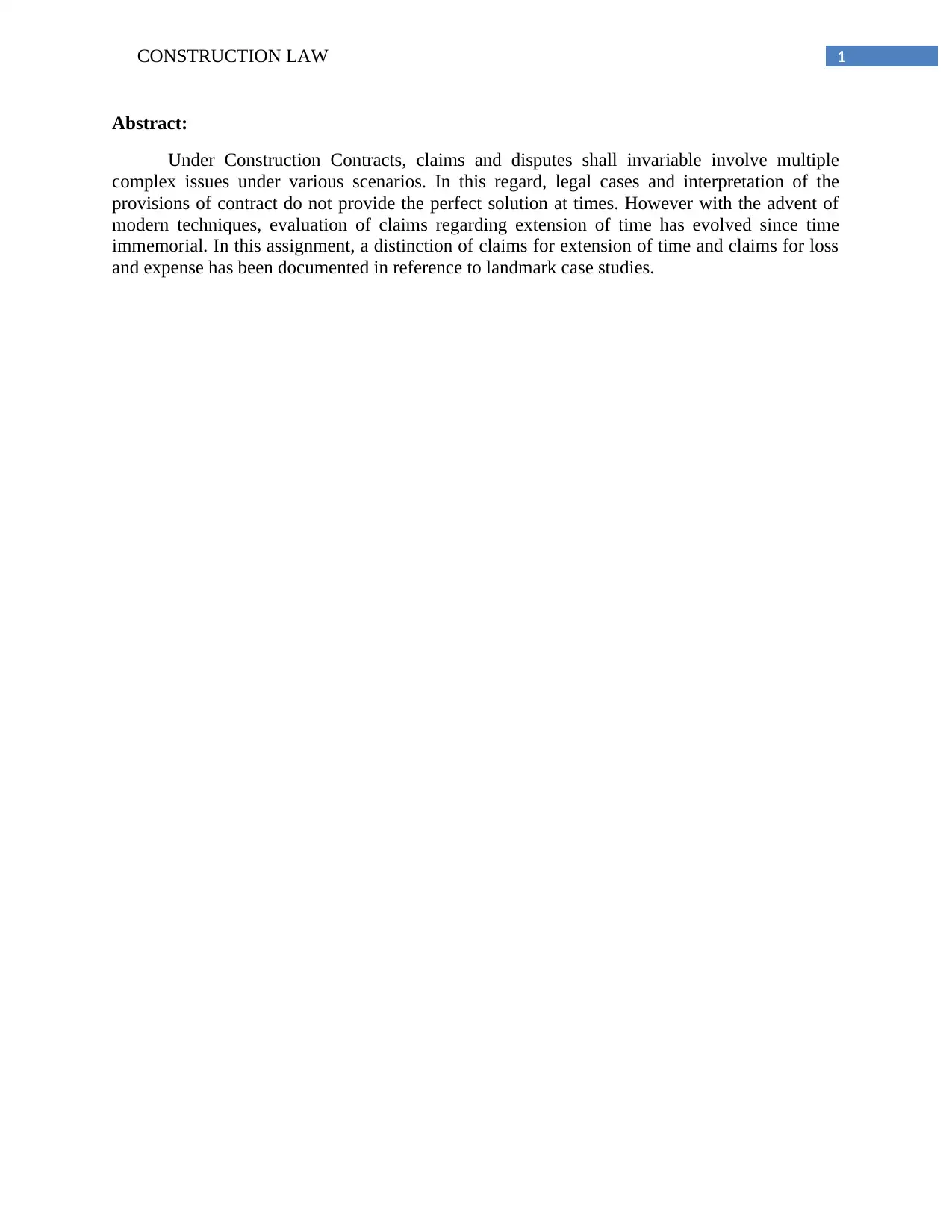
1CONSTRUCTION LAW
Abstract:
Under Construction Contracts, claims and disputes shall invariable involve multiple
complex issues under various scenarios. In this regard, legal cases and interpretation of the
provisions of contract do not provide the perfect solution at times. However with the advent of
modern techniques, evaluation of claims regarding extension of time has evolved since time
immemorial. In this assignment, a distinction of claims for extension of time and claims for loss
and expense has been documented in reference to landmark case studies.
Abstract:
Under Construction Contracts, claims and disputes shall invariable involve multiple
complex issues under various scenarios. In this regard, legal cases and interpretation of the
provisions of contract do not provide the perfect solution at times. However with the advent of
modern techniques, evaluation of claims regarding extension of time has evolved since time
immemorial. In this assignment, a distinction of claims for extension of time and claims for loss
and expense has been documented in reference to landmark case studies.
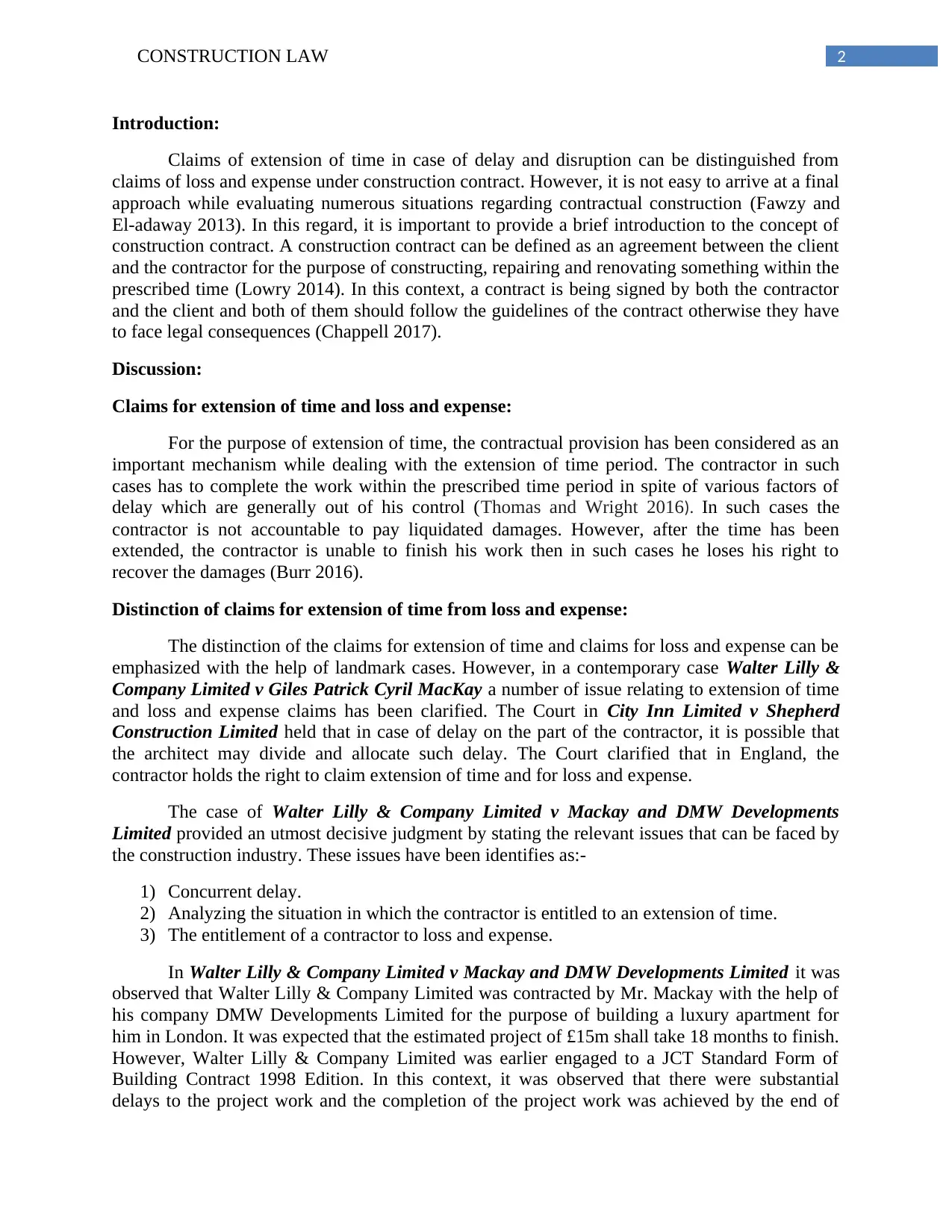
2CONSTRUCTION LAW
Introduction:
Claims of extension of time in case of delay and disruption can be distinguished from
claims of loss and expense under construction contract. However, it is not easy to arrive at a final
approach while evaluating numerous situations regarding contractual construction (Fawzy and
El-adaway 2013). In this regard, it is important to provide a brief introduction to the concept of
construction contract. A construction contract can be defined as an agreement between the client
and the contractor for the purpose of constructing, repairing and renovating something within the
prescribed time (Lowry 2014). In this context, a contract is being signed by both the contractor
and the client and both of them should follow the guidelines of the contract otherwise they have
to face legal consequences (Chappell 2017).
Discussion:
Claims for extension of time and loss and expense:
For the purpose of extension of time, the contractual provision has been considered as an
important mechanism while dealing with the extension of time period. The contractor in such
cases has to complete the work within the prescribed time period in spite of various factors of
delay which are generally out of his control (Thomas and Wright 2016). In such cases the
contractor is not accountable to pay liquidated damages. However, after the time has been
extended, the contractor is unable to finish his work then in such cases he loses his right to
recover the damages (Burr 2016).
Distinction of claims for extension of time from loss and expense:
The distinction of the claims for extension of time and claims for loss and expense can be
emphasized with the help of landmark cases. However, in a contemporary case Walter Lilly &
Company Limited v Giles Patrick Cyril MacKay a number of issue relating to extension of time
and loss and expense claims has been clarified. The Court in City Inn Limited v Shepherd
Construction Limited held that in case of delay on the part of the contractor, it is possible that
the architect may divide and allocate such delay. The Court clarified that in England, the
contractor holds the right to claim extension of time and for loss and expense.
The case of Walter Lilly & Company Limited v Mackay and DMW Developments
Limited provided an utmost decisive judgment by stating the relevant issues that can be faced by
the construction industry. These issues have been identifies as:-
1) Concurrent delay.
2) Analyzing the situation in which the contractor is entitled to an extension of time.
3) The entitlement of a contractor to loss and expense.
In Walter Lilly & Company Limited v Mackay and DMW Developments Limited it was
observed that Walter Lilly & Company Limited was contracted by Mr. Mackay with the help of
his company DMW Developments Limited for the purpose of building a luxury apartment for
him in London. It was expected that the estimated project of £15m shall take 18 months to finish.
However, Walter Lilly & Company Limited was earlier engaged to a JCT Standard Form of
Building Contract 1998 Edition. In this context, it was observed that there were substantial
delays to the project work and the completion of the project work was achieved by the end of
Introduction:
Claims of extension of time in case of delay and disruption can be distinguished from
claims of loss and expense under construction contract. However, it is not easy to arrive at a final
approach while evaluating numerous situations regarding contractual construction (Fawzy and
El-adaway 2013). In this regard, it is important to provide a brief introduction to the concept of
construction contract. A construction contract can be defined as an agreement between the client
and the contractor for the purpose of constructing, repairing and renovating something within the
prescribed time (Lowry 2014). In this context, a contract is being signed by both the contractor
and the client and both of them should follow the guidelines of the contract otherwise they have
to face legal consequences (Chappell 2017).
Discussion:
Claims for extension of time and loss and expense:
For the purpose of extension of time, the contractual provision has been considered as an
important mechanism while dealing with the extension of time period. The contractor in such
cases has to complete the work within the prescribed time period in spite of various factors of
delay which are generally out of his control (Thomas and Wright 2016). In such cases the
contractor is not accountable to pay liquidated damages. However, after the time has been
extended, the contractor is unable to finish his work then in such cases he loses his right to
recover the damages (Burr 2016).
Distinction of claims for extension of time from loss and expense:
The distinction of the claims for extension of time and claims for loss and expense can be
emphasized with the help of landmark cases. However, in a contemporary case Walter Lilly &
Company Limited v Giles Patrick Cyril MacKay a number of issue relating to extension of time
and loss and expense claims has been clarified. The Court in City Inn Limited v Shepherd
Construction Limited held that in case of delay on the part of the contractor, it is possible that
the architect may divide and allocate such delay. The Court clarified that in England, the
contractor holds the right to claim extension of time and for loss and expense.
The case of Walter Lilly & Company Limited v Mackay and DMW Developments
Limited provided an utmost decisive judgment by stating the relevant issues that can be faced by
the construction industry. These issues have been identifies as:-
1) Concurrent delay.
2) Analyzing the situation in which the contractor is entitled to an extension of time.
3) The entitlement of a contractor to loss and expense.
In Walter Lilly & Company Limited v Mackay and DMW Developments Limited it was
observed that Walter Lilly & Company Limited was contracted by Mr. Mackay with the help of
his company DMW Developments Limited for the purpose of building a luxury apartment for
him in London. It was expected that the estimated project of £15m shall take 18 months to finish.
However, Walter Lilly & Company Limited was earlier engaged to a JCT Standard Form of
Building Contract 1998 Edition. In this context, it was observed that there were substantial
delays to the project work and the completion of the project work was achieved by the end of
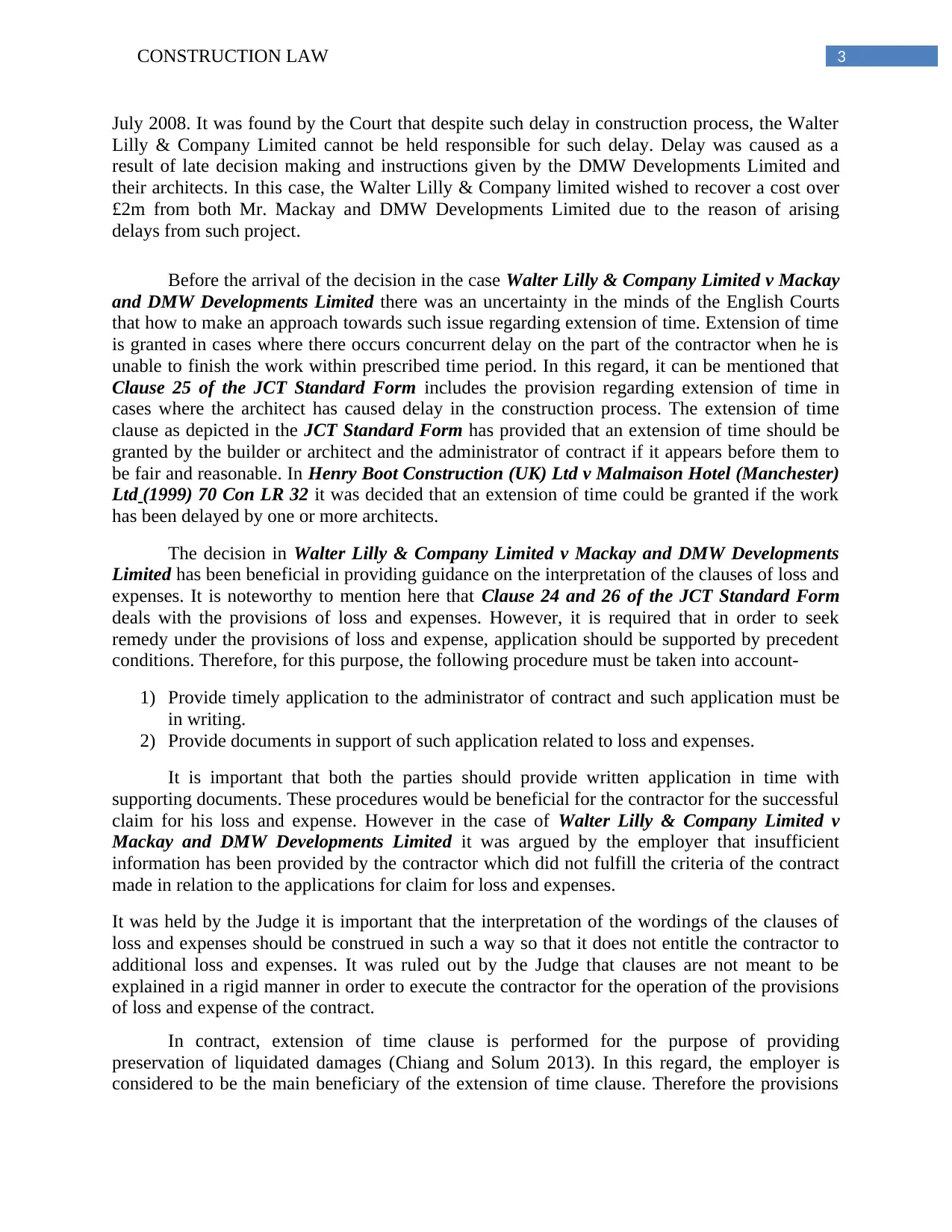
3CONSTRUCTION LAW
July 2008. It was found by the Court that despite such delay in construction process, the Walter
Lilly & Company Limited cannot be held responsible for such delay. Delay was caused as a
result of late decision making and instructions given by the DMW Developments Limited and
their architects. In this case, the Walter Lilly & Company limited wished to recover a cost over
£2m from both Mr. Mackay and DMW Developments Limited due to the reason of arising
delays from such project.
Before the arrival of the decision in the case Walter Lilly & Company Limited v Mackay
and DMW Developments Limited there was an uncertainty in the minds of the English Courts
that how to make an approach towards such issue regarding extension of time. Extension of time
is granted in cases where there occurs concurrent delay on the part of the contractor when he is
unable to finish the work within prescribed time period. In this regard, it can be mentioned that
Clause 25 of the JCT Standard Form includes the provision regarding extension of time in
cases where the architect has caused delay in the construction process. The extension of time
clause as depicted in the JCT Standard Form has provided that an extension of time should be
granted by the builder or architect and the administrator of contract if it appears before them to
be fair and reasonable. In Henry Boot Construction (UK) Ltd v Malmaison Hotel (Manchester)
Ltd (1999) 70 Con LR 32 it was decided that an extension of time could be granted if the work
has been delayed by one or more architects.
The decision in Walter Lilly & Company Limited v Mackay and DMW Developments
Limited has been beneficial in providing guidance on the interpretation of the clauses of loss and
expenses. It is noteworthy to mention here that Clause 24 and 26 of the JCT Standard Form
deals with the provisions of loss and expenses. However, it is required that in order to seek
remedy under the provisions of loss and expense, application should be supported by precedent
conditions. Therefore, for this purpose, the following procedure must be taken into account-
1) Provide timely application to the administrator of contract and such application must be
in writing.
2) Provide documents in support of such application related to loss and expenses.
It is important that both the parties should provide written application in time with
supporting documents. These procedures would be beneficial for the contractor for the successful
claim for his loss and expense. However in the case of Walter Lilly & Company Limited v
Mackay and DMW Developments Limited it was argued by the employer that insufficient
information has been provided by the contractor which did not fulfill the criteria of the contract
made in relation to the applications for claim for loss and expenses.
It was held by the Judge it is important that the interpretation of the wordings of the clauses of
loss and expenses should be construed in such a way so that it does not entitle the contractor to
additional loss and expenses. It was ruled out by the Judge that clauses are not meant to be
explained in a rigid manner in order to execute the contractor for the operation of the provisions
of loss and expense of the contract.
In contract, extension of time clause is performed for the purpose of providing
preservation of liquidated damages (Chiang and Solum 2013). In this regard, the employer is
considered to be the main beneficiary of the extension of time clause. Therefore the provisions
July 2008. It was found by the Court that despite such delay in construction process, the Walter
Lilly & Company Limited cannot be held responsible for such delay. Delay was caused as a
result of late decision making and instructions given by the DMW Developments Limited and
their architects. In this case, the Walter Lilly & Company limited wished to recover a cost over
£2m from both Mr. Mackay and DMW Developments Limited due to the reason of arising
delays from such project.
Before the arrival of the decision in the case Walter Lilly & Company Limited v Mackay
and DMW Developments Limited there was an uncertainty in the minds of the English Courts
that how to make an approach towards such issue regarding extension of time. Extension of time
is granted in cases where there occurs concurrent delay on the part of the contractor when he is
unable to finish the work within prescribed time period. In this regard, it can be mentioned that
Clause 25 of the JCT Standard Form includes the provision regarding extension of time in
cases where the architect has caused delay in the construction process. The extension of time
clause as depicted in the JCT Standard Form has provided that an extension of time should be
granted by the builder or architect and the administrator of contract if it appears before them to
be fair and reasonable. In Henry Boot Construction (UK) Ltd v Malmaison Hotel (Manchester)
Ltd (1999) 70 Con LR 32 it was decided that an extension of time could be granted if the work
has been delayed by one or more architects.
The decision in Walter Lilly & Company Limited v Mackay and DMW Developments
Limited has been beneficial in providing guidance on the interpretation of the clauses of loss and
expenses. It is noteworthy to mention here that Clause 24 and 26 of the JCT Standard Form
deals with the provisions of loss and expenses. However, it is required that in order to seek
remedy under the provisions of loss and expense, application should be supported by precedent
conditions. Therefore, for this purpose, the following procedure must be taken into account-
1) Provide timely application to the administrator of contract and such application must be
in writing.
2) Provide documents in support of such application related to loss and expenses.
It is important that both the parties should provide written application in time with
supporting documents. These procedures would be beneficial for the contractor for the successful
claim for his loss and expense. However in the case of Walter Lilly & Company Limited v
Mackay and DMW Developments Limited it was argued by the employer that insufficient
information has been provided by the contractor which did not fulfill the criteria of the contract
made in relation to the applications for claim for loss and expenses.
It was held by the Judge it is important that the interpretation of the wordings of the clauses of
loss and expenses should be construed in such a way so that it does not entitle the contractor to
additional loss and expenses. It was ruled out by the Judge that clauses are not meant to be
explained in a rigid manner in order to execute the contractor for the operation of the provisions
of loss and expense of the contract.
In contract, extension of time clause is performed for the purpose of providing
preservation of liquidated damages (Chiang and Solum 2013). In this regard, the employer is
considered to be the main beneficiary of the extension of time clause. Therefore the provisions
Paraphrase This Document
Need a fresh take? Get an instant paraphrase of this document with our AI Paraphraser
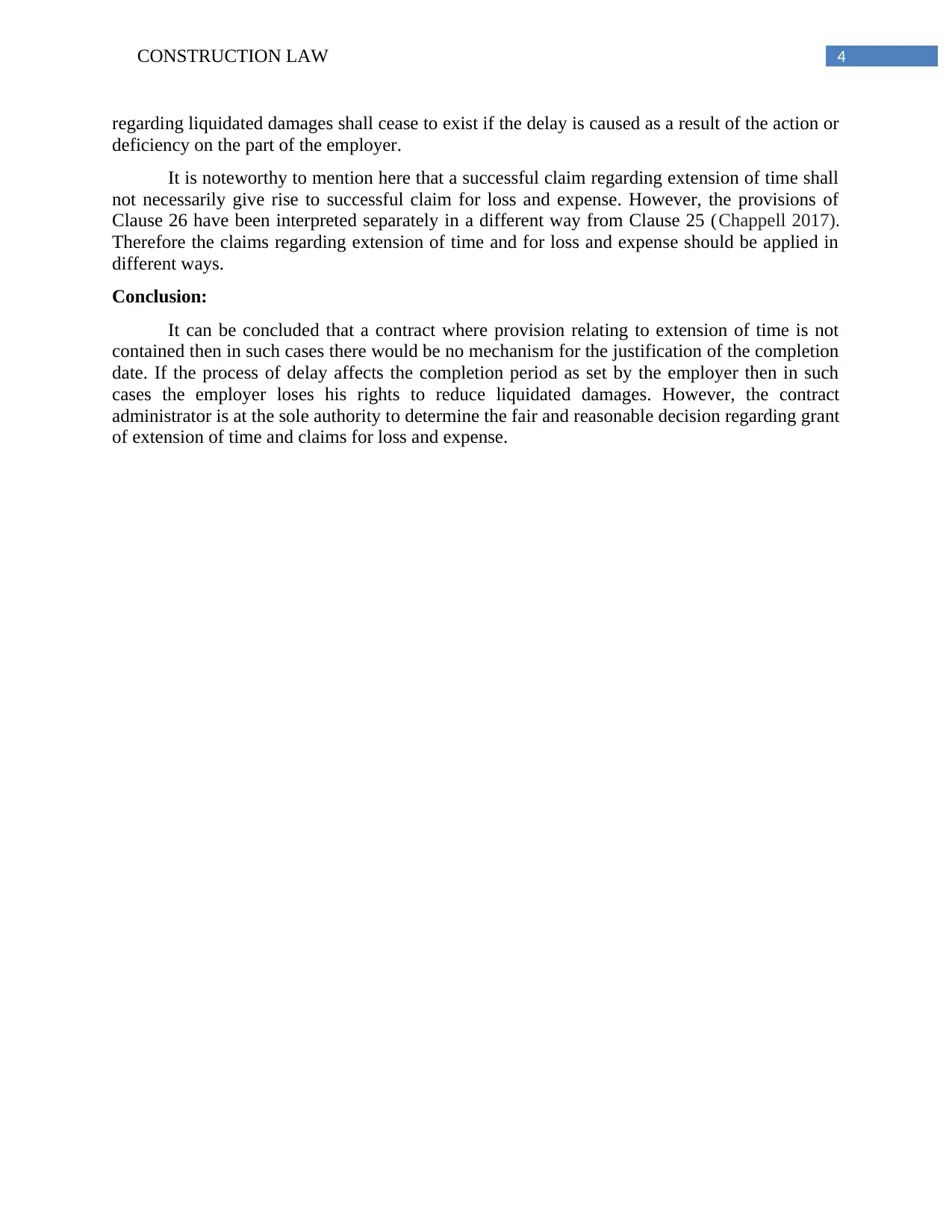
4CONSTRUCTION LAW
regarding liquidated damages shall cease to exist if the delay is caused as a result of the action or
deficiency on the part of the employer.
It is noteworthy to mention here that a successful claim regarding extension of time shall
not necessarily give rise to successful claim for loss and expense. However, the provisions of
Clause 26 have been interpreted separately in a different way from Clause 25 (Chappell 2017).
Therefore the claims regarding extension of time and for loss and expense should be applied in
different ways.
Conclusion:
It can be concluded that a contract where provision relating to extension of time is not
contained then in such cases there would be no mechanism for the justification of the completion
date. If the process of delay affects the completion period as set by the employer then in such
cases the employer loses his rights to reduce liquidated damages. However, the contract
administrator is at the sole authority to determine the fair and reasonable decision regarding grant
of extension of time and claims for loss and expense.
regarding liquidated damages shall cease to exist if the delay is caused as a result of the action or
deficiency on the part of the employer.
It is noteworthy to mention here that a successful claim regarding extension of time shall
not necessarily give rise to successful claim for loss and expense. However, the provisions of
Clause 26 have been interpreted separately in a different way from Clause 25 (Chappell 2017).
Therefore the claims regarding extension of time and for loss and expense should be applied in
different ways.
Conclusion:
It can be concluded that a contract where provision relating to extension of time is not
contained then in such cases there would be no mechanism for the justification of the completion
date. If the process of delay affects the completion period as set by the employer then in such
cases the employer loses his rights to reduce liquidated damages. However, the contract
administrator is at the sole authority to determine the fair and reasonable decision regarding grant
of extension of time and claims for loss and expense.
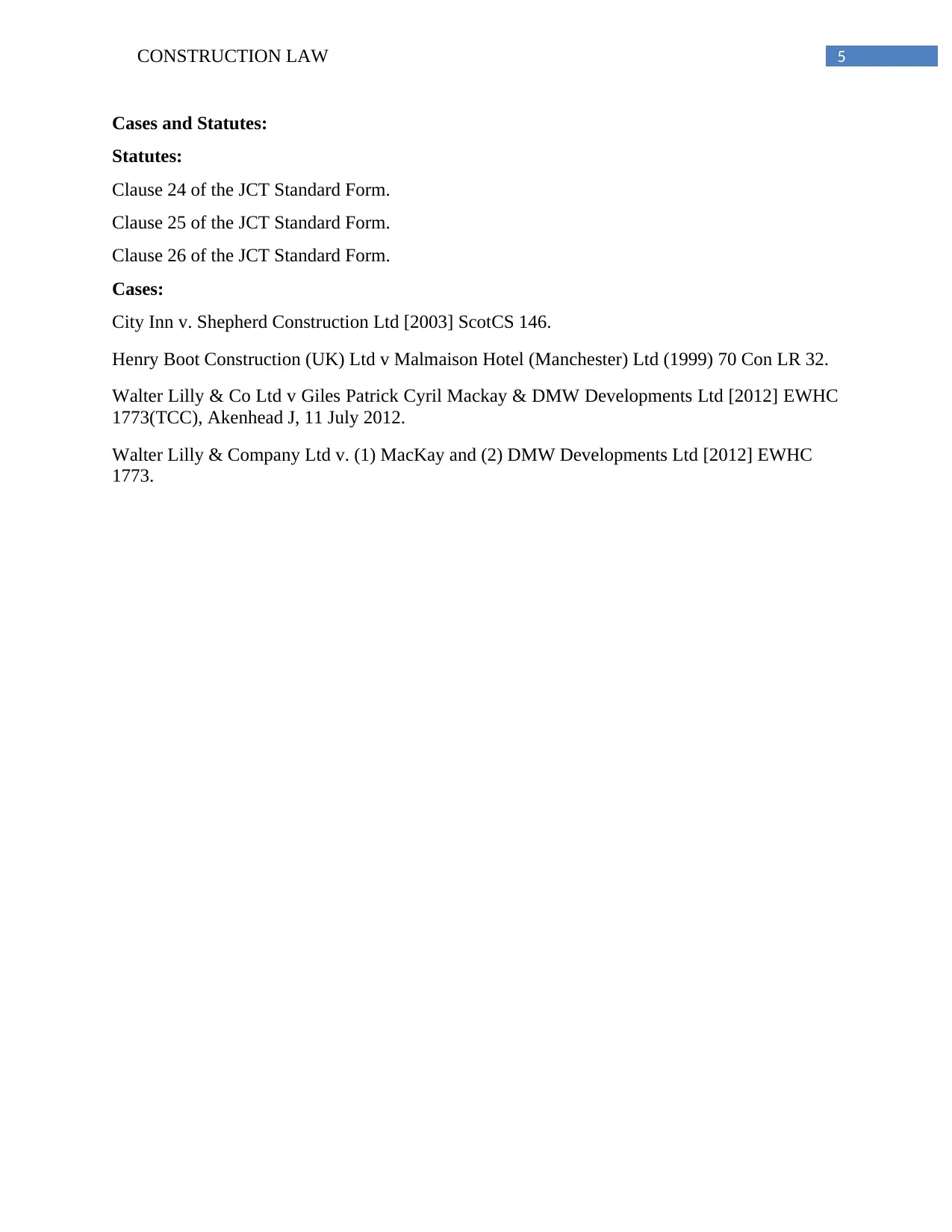
5CONSTRUCTION LAW
Cases and Statutes:
Statutes:
Clause 24 of the JCT Standard Form.
Clause 25 of the JCT Standard Form.
Clause 26 of the JCT Standard Form.
Cases:
City Inn v. Shepherd Construction Ltd [2003] ScotCS 146.
Henry Boot Construction (UK) Ltd v Malmaison Hotel (Manchester) Ltd (1999) 70 Con LR 32.
Walter Lilly & Co Ltd v Giles Patrick Cyril Mackay & DMW Developments Ltd [2012] EWHC
1773(TCC), Akenhead J, 11 July 2012.
Walter Lilly & Company Ltd v. (1) MacKay and (2) DMW Developments Ltd [2012] EWHC
1773.
Cases and Statutes:
Statutes:
Clause 24 of the JCT Standard Form.
Clause 25 of the JCT Standard Form.
Clause 26 of the JCT Standard Form.
Cases:
City Inn v. Shepherd Construction Ltd [2003] ScotCS 146.
Henry Boot Construction (UK) Ltd v Malmaison Hotel (Manchester) Ltd (1999) 70 Con LR 32.
Walter Lilly & Co Ltd v Giles Patrick Cyril Mackay & DMW Developments Ltd [2012] EWHC
1773(TCC), Akenhead J, 11 July 2012.
Walter Lilly & Company Ltd v. (1) MacKay and (2) DMW Developments Ltd [2012] EWHC
1773.

6CONSTRUCTION LAW
References:
Burr, A. ed., 2016. Delay and disruption in construction contracts. CRC Press.
Chappell, D., 2017. Understanding JCT standard building contracts. Routledge.
Chiang, T.J. and Solum, L.B., 2013. The Interpretation-Construction Distinction in Patent
Law. Yale LJ, 123, p.530.
Fawzy, S.A. and El-adaway, I.H., 2013. Time at large within the common law legal system:
Application to standard forms of contract. Journal of Legal Affairs and Dispute Resolution in
Engineering and Construction, 6(1), p.04513002.
Lowry, S., 2014. Tax Deductions for Individuals: A Summary. Congressional Research Service,
Washington.
Thomas, R.W. and Wright, M., 2016. Construction contract claims. Palgrave Macmillan.
References:
Burr, A. ed., 2016. Delay and disruption in construction contracts. CRC Press.
Chappell, D., 2017. Understanding JCT standard building contracts. Routledge.
Chiang, T.J. and Solum, L.B., 2013. The Interpretation-Construction Distinction in Patent
Law. Yale LJ, 123, p.530.
Fawzy, S.A. and El-adaway, I.H., 2013. Time at large within the common law legal system:
Application to standard forms of contract. Journal of Legal Affairs and Dispute Resolution in
Engineering and Construction, 6(1), p.04513002.
Lowry, S., 2014. Tax Deductions for Individuals: A Summary. Congressional Research Service,
Washington.
Thomas, R.W. and Wright, M., 2016. Construction contract claims. Palgrave Macmillan.
Secure Best Marks with AI Grader
Need help grading? Try our AI Grader for instant feedback on your assignments.
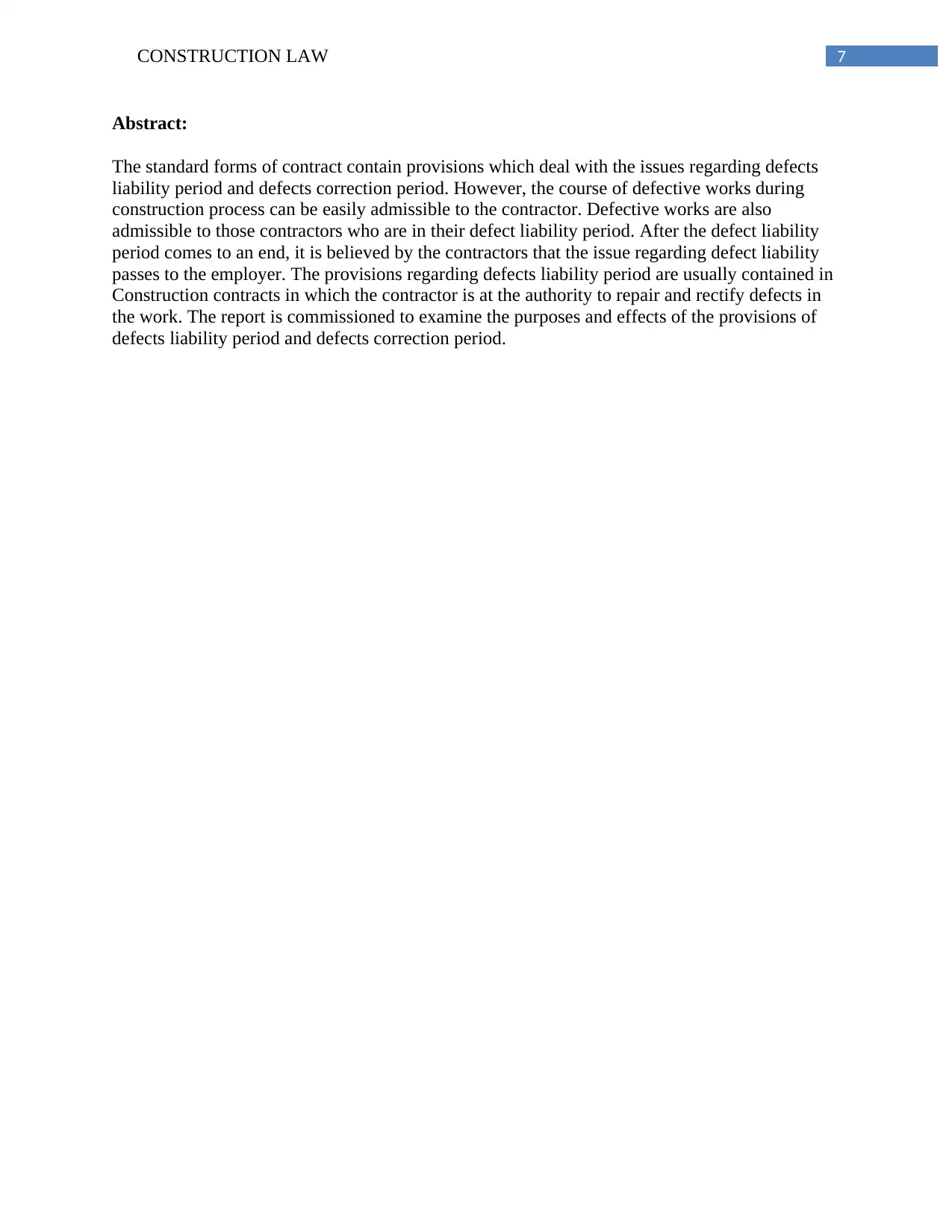
7CONSTRUCTION LAW
Abstract:
The standard forms of contract contain provisions which deal with the issues regarding defects
liability period and defects correction period. However, the course of defective works during
construction process can be easily admissible to the contractor. Defective works are also
admissible to those contractors who are in their defect liability period. After the defect liability
period comes to an end, it is believed by the contractors that the issue regarding defect liability
passes to the employer. The provisions regarding defects liability period are usually contained in
Construction contracts in which the contractor is at the authority to repair and rectify defects in
the work. The report is commissioned to examine the purposes and effects of the provisions of
defects liability period and defects correction period.
Abstract:
The standard forms of contract contain provisions which deal with the issues regarding defects
liability period and defects correction period. However, the course of defective works during
construction process can be easily admissible to the contractor. Defective works are also
admissible to those contractors who are in their defect liability period. After the defect liability
period comes to an end, it is believed by the contractors that the issue regarding defect liability
passes to the employer. The provisions regarding defects liability period are usually contained in
Construction contracts in which the contractor is at the authority to repair and rectify defects in
the work. The report is commissioned to examine the purposes and effects of the provisions of
defects liability period and defects correction period.
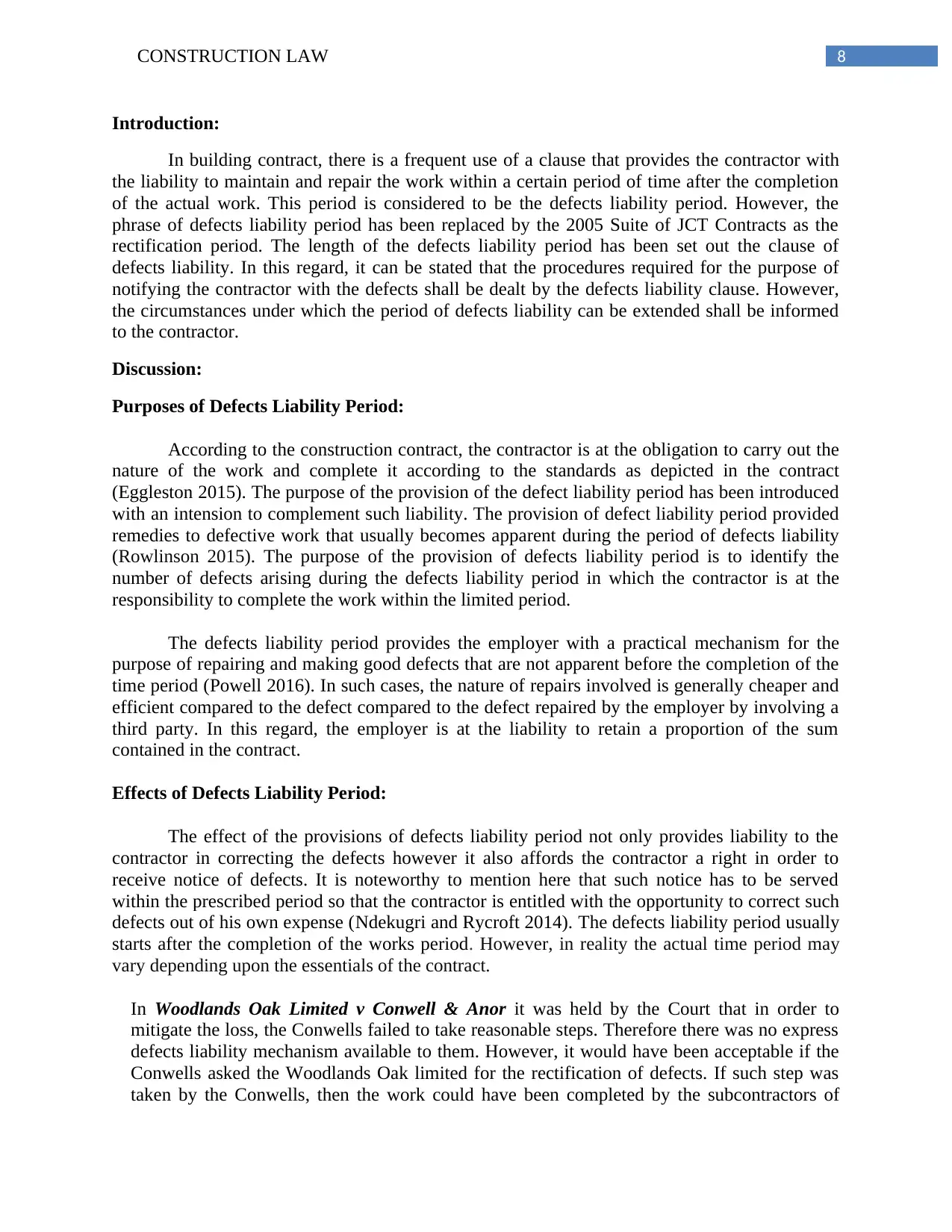
8CONSTRUCTION LAW
Introduction:
In building contract, there is a frequent use of a clause that provides the contractor with
the liability to maintain and repair the work within a certain period of time after the completion
of the actual work. This period is considered to be the defects liability period. However, the
phrase of defects liability period has been replaced by the 2005 Suite of JCT Contracts as the
rectification period. The length of the defects liability period has been set out the clause of
defects liability. In this regard, it can be stated that the procedures required for the purpose of
notifying the contractor with the defects shall be dealt by the defects liability clause. However,
the circumstances under which the period of defects liability can be extended shall be informed
to the contractor.
Discussion:
Purposes of Defects Liability Period:
According to the construction contract, the contractor is at the obligation to carry out the
nature of the work and complete it according to the standards as depicted in the contract
(Eggleston 2015). The purpose of the provision of the defect liability period has been introduced
with an intension to complement such liability. The provision of defect liability period provided
remedies to defective work that usually becomes apparent during the period of defects liability
(Rowlinson 2015). The purpose of the provision of defects liability period is to identify the
number of defects arising during the defects liability period in which the contractor is at the
responsibility to complete the work within the limited period.
The defects liability period provides the employer with a practical mechanism for the
purpose of repairing and making good defects that are not apparent before the completion of the
time period (Powell 2016). In such cases, the nature of repairs involved is generally cheaper and
efficient compared to the defect compared to the defect repaired by the employer by involving a
third party. In this regard, the employer is at the liability to retain a proportion of the sum
contained in the contract.
Effects of Defects Liability Period:
The effect of the provisions of defects liability period not only provides liability to the
contractor in correcting the defects however it also affords the contractor a right in order to
receive notice of defects. It is noteworthy to mention here that such notice has to be served
within the prescribed period so that the contractor is entitled with the opportunity to correct such
defects out of his own expense (Ndekugri and Rycroft 2014). The defects liability period usually
starts after the completion of the works period. However, in reality the actual time period may
vary depending upon the essentials of the contract.
In Woodlands Oak Limited v Conwell & Anor it was held by the Court that in order to
mitigate the loss, the Conwells failed to take reasonable steps. Therefore there was no express
defects liability mechanism available to them. However, it would have been acceptable if the
Conwells asked the Woodlands Oak limited for the rectification of defects. If such step was
taken by the Conwells, then the work could have been completed by the subcontractors of
Introduction:
In building contract, there is a frequent use of a clause that provides the contractor with
the liability to maintain and repair the work within a certain period of time after the completion
of the actual work. This period is considered to be the defects liability period. However, the
phrase of defects liability period has been replaced by the 2005 Suite of JCT Contracts as the
rectification period. The length of the defects liability period has been set out the clause of
defects liability. In this regard, it can be stated that the procedures required for the purpose of
notifying the contractor with the defects shall be dealt by the defects liability clause. However,
the circumstances under which the period of defects liability can be extended shall be informed
to the contractor.
Discussion:
Purposes of Defects Liability Period:
According to the construction contract, the contractor is at the obligation to carry out the
nature of the work and complete it according to the standards as depicted in the contract
(Eggleston 2015). The purpose of the provision of the defect liability period has been introduced
with an intension to complement such liability. The provision of defect liability period provided
remedies to defective work that usually becomes apparent during the period of defects liability
(Rowlinson 2015). The purpose of the provision of defects liability period is to identify the
number of defects arising during the defects liability period in which the contractor is at the
responsibility to complete the work within the limited period.
The defects liability period provides the employer with a practical mechanism for the
purpose of repairing and making good defects that are not apparent before the completion of the
time period (Powell 2016). In such cases, the nature of repairs involved is generally cheaper and
efficient compared to the defect compared to the defect repaired by the employer by involving a
third party. In this regard, the employer is at the liability to retain a proportion of the sum
contained in the contract.
Effects of Defects Liability Period:
The effect of the provisions of defects liability period not only provides liability to the
contractor in correcting the defects however it also affords the contractor a right in order to
receive notice of defects. It is noteworthy to mention here that such notice has to be served
within the prescribed period so that the contractor is entitled with the opportunity to correct such
defects out of his own expense (Ndekugri and Rycroft 2014). The defects liability period usually
starts after the completion of the works period. However, in reality the actual time period may
vary depending upon the essentials of the contract.
In Woodlands Oak Limited v Conwell & Anor it was held by the Court that in order to
mitigate the loss, the Conwells failed to take reasonable steps. Therefore there was no express
defects liability mechanism available to them. However, it would have been acceptable if the
Conwells asked the Woodlands Oak limited for the rectification of defects. If such step was
taken by the Conwells, then the work could have been completed by the subcontractors of
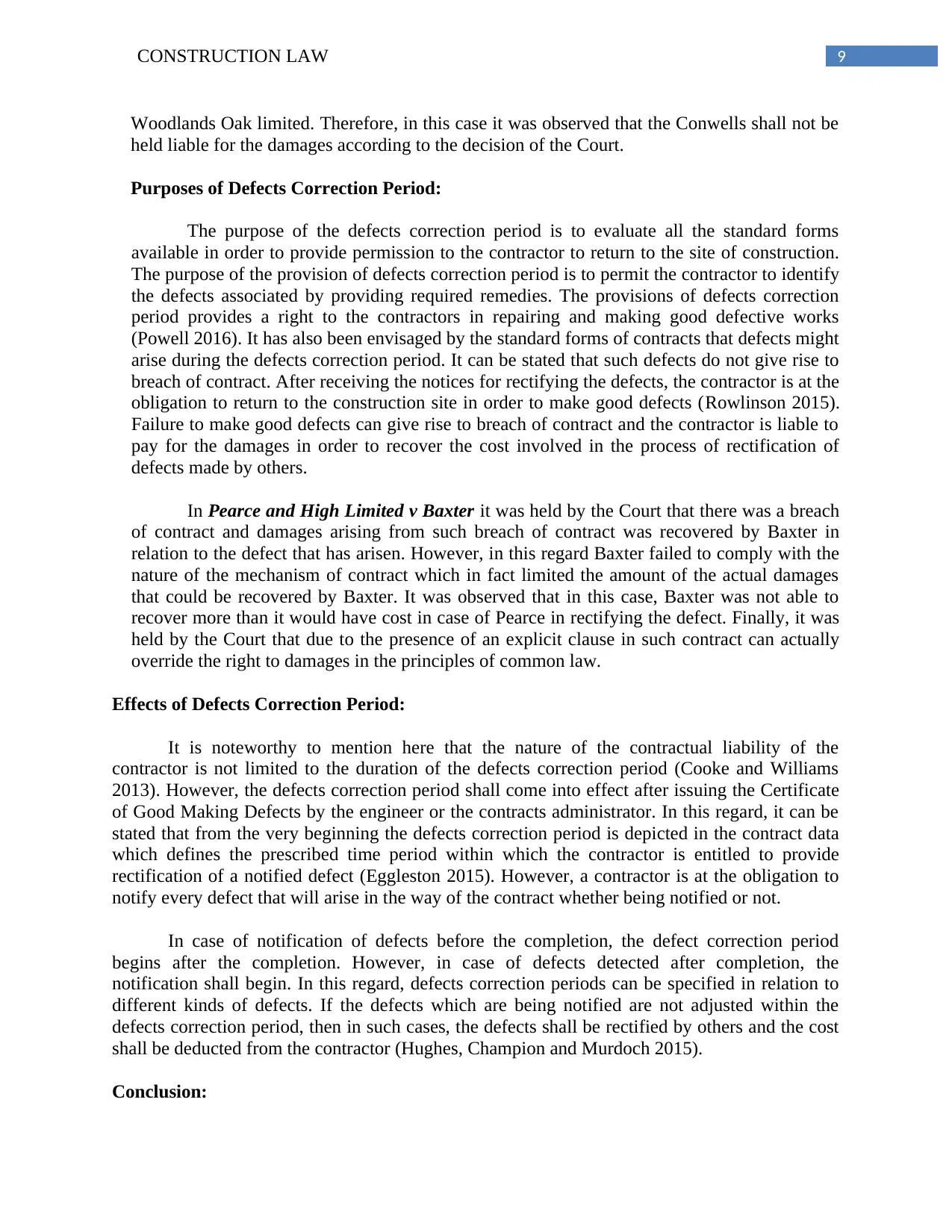
9CONSTRUCTION LAW
Woodlands Oak limited. Therefore, in this case it was observed that the Conwells shall not be
held liable for the damages according to the decision of the Court.
Purposes of Defects Correction Period:
The purpose of the defects correction period is to evaluate all the standard forms
available in order to provide permission to the contractor to return to the site of construction.
The purpose of the provision of defects correction period is to permit the contractor to identify
the defects associated by providing required remedies. The provisions of defects correction
period provides a right to the contractors in repairing and making good defective works
(Powell 2016). It has also been envisaged by the standard forms of contracts that defects might
arise during the defects correction period. It can be stated that such defects do not give rise to
breach of contract. After receiving the notices for rectifying the defects, the contractor is at the
obligation to return to the construction site in order to make good defects (Rowlinson 2015).
Failure to make good defects can give rise to breach of contract and the contractor is liable to
pay for the damages in order to recover the cost involved in the process of rectification of
defects made by others.
In Pearce and High Limited v Baxter it was held by the Court that there was a breach
of contract and damages arising from such breach of contract was recovered by Baxter in
relation to the defect that has arisen. However, in this regard Baxter failed to comply with the
nature of the mechanism of contract which in fact limited the amount of the actual damages
that could be recovered by Baxter. It was observed that in this case, Baxter was not able to
recover more than it would have cost in case of Pearce in rectifying the defect. Finally, it was
held by the Court that due to the presence of an explicit clause in such contract can actually
override the right to damages in the principles of common law.
Effects of Defects Correction Period:
It is noteworthy to mention here that the nature of the contractual liability of the
contractor is not limited to the duration of the defects correction period (Cooke and Williams
2013). However, the defects correction period shall come into effect after issuing the Certificate
of Good Making Defects by the engineer or the contracts administrator. In this regard, it can be
stated that from the very beginning the defects correction period is depicted in the contract data
which defines the prescribed time period within which the contractor is entitled to provide
rectification of a notified defect (Eggleston 2015). However, a contractor is at the obligation to
notify every defect that will arise in the way of the contract whether being notified or not.
In case of notification of defects before the completion, the defect correction period
begins after the completion. However, in case of defects detected after completion, the
notification shall begin. In this regard, defects correction periods can be specified in relation to
different kinds of defects. If the defects which are being notified are not adjusted within the
defects correction period, then in such cases, the defects shall be rectified by others and the cost
shall be deducted from the contractor (Hughes, Champion and Murdoch 2015).
Conclusion:
Woodlands Oak limited. Therefore, in this case it was observed that the Conwells shall not be
held liable for the damages according to the decision of the Court.
Purposes of Defects Correction Period:
The purpose of the defects correction period is to evaluate all the standard forms
available in order to provide permission to the contractor to return to the site of construction.
The purpose of the provision of defects correction period is to permit the contractor to identify
the defects associated by providing required remedies. The provisions of defects correction
period provides a right to the contractors in repairing and making good defective works
(Powell 2016). It has also been envisaged by the standard forms of contracts that defects might
arise during the defects correction period. It can be stated that such defects do not give rise to
breach of contract. After receiving the notices for rectifying the defects, the contractor is at the
obligation to return to the construction site in order to make good defects (Rowlinson 2015).
Failure to make good defects can give rise to breach of contract and the contractor is liable to
pay for the damages in order to recover the cost involved in the process of rectification of
defects made by others.
In Pearce and High Limited v Baxter it was held by the Court that there was a breach
of contract and damages arising from such breach of contract was recovered by Baxter in
relation to the defect that has arisen. However, in this regard Baxter failed to comply with the
nature of the mechanism of contract which in fact limited the amount of the actual damages
that could be recovered by Baxter. It was observed that in this case, Baxter was not able to
recover more than it would have cost in case of Pearce in rectifying the defect. Finally, it was
held by the Court that due to the presence of an explicit clause in such contract can actually
override the right to damages in the principles of common law.
Effects of Defects Correction Period:
It is noteworthy to mention here that the nature of the contractual liability of the
contractor is not limited to the duration of the defects correction period (Cooke and Williams
2013). However, the defects correction period shall come into effect after issuing the Certificate
of Good Making Defects by the engineer or the contracts administrator. In this regard, it can be
stated that from the very beginning the defects correction period is depicted in the contract data
which defines the prescribed time period within which the contractor is entitled to provide
rectification of a notified defect (Eggleston 2015). However, a contractor is at the obligation to
notify every defect that will arise in the way of the contract whether being notified or not.
In case of notification of defects before the completion, the defect correction period
begins after the completion. However, in case of defects detected after completion, the
notification shall begin. In this regard, defects correction periods can be specified in relation to
different kinds of defects. If the defects which are being notified are not adjusted within the
defects correction period, then in such cases, the defects shall be rectified by others and the cost
shall be deducted from the contractor (Hughes, Champion and Murdoch 2015).
Conclusion:
Paraphrase This Document
Need a fresh take? Get an instant paraphrase of this document with our AI Paraphraser
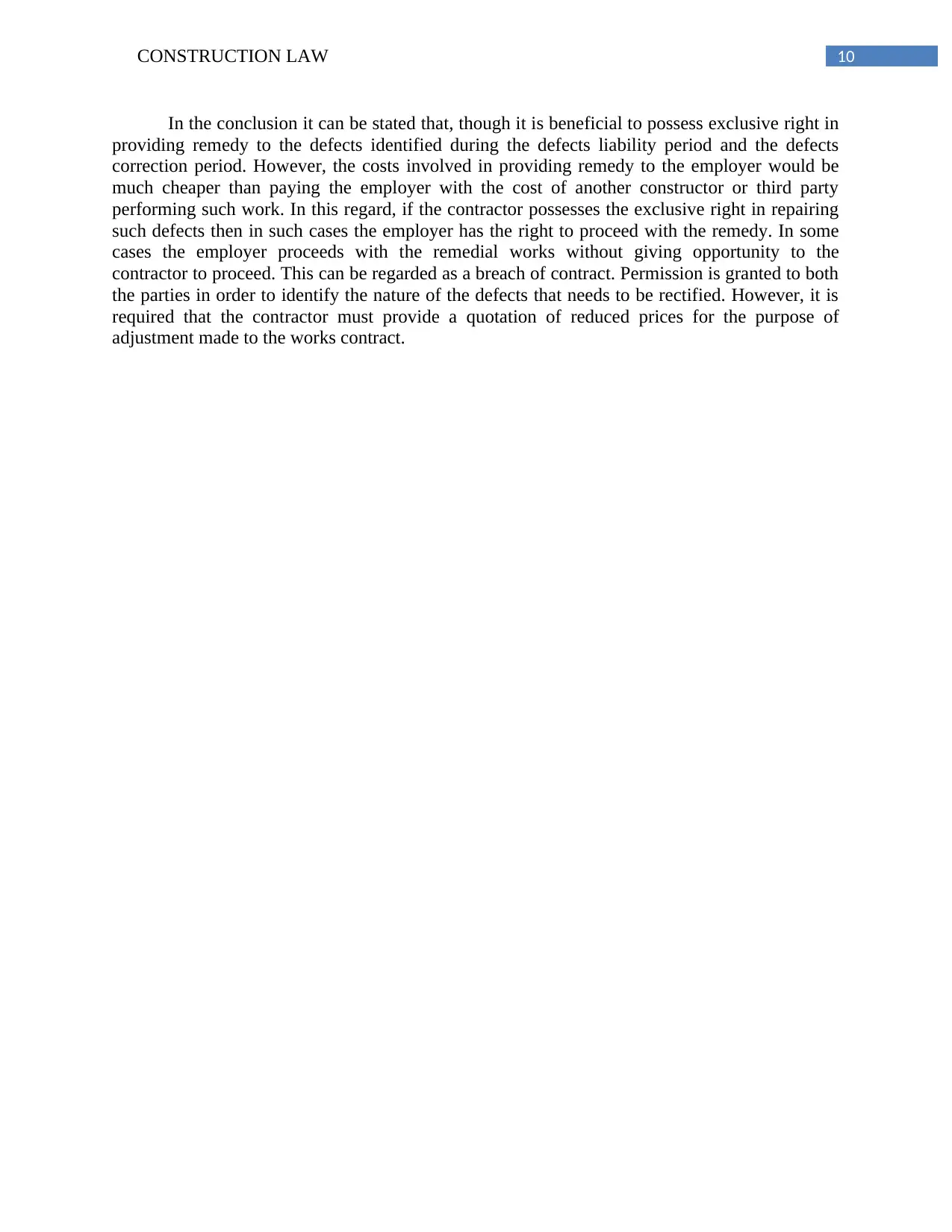
10CONSTRUCTION LAW
In the conclusion it can be stated that, though it is beneficial to possess exclusive right in
providing remedy to the defects identified during the defects liability period and the defects
correction period. However, the costs involved in providing remedy to the employer would be
much cheaper than paying the employer with the cost of another constructor or third party
performing such work. In this regard, if the contractor possesses the exclusive right in repairing
such defects then in such cases the employer has the right to proceed with the remedy. In some
cases the employer proceeds with the remedial works without giving opportunity to the
contractor to proceed. This can be regarded as a breach of contract. Permission is granted to both
the parties in order to identify the nature of the defects that needs to be rectified. However, it is
required that the contractor must provide a quotation of reduced prices for the purpose of
adjustment made to the works contract.
In the conclusion it can be stated that, though it is beneficial to possess exclusive right in
providing remedy to the defects identified during the defects liability period and the defects
correction period. However, the costs involved in providing remedy to the employer would be
much cheaper than paying the employer with the cost of another constructor or third party
performing such work. In this regard, if the contractor possesses the exclusive right in repairing
such defects then in such cases the employer has the right to proceed with the remedy. In some
cases the employer proceeds with the remedial works without giving opportunity to the
contractor to proceed. This can be regarded as a breach of contract. Permission is granted to both
the parties in order to identify the nature of the defects that needs to be rectified. However, it is
required that the contractor must provide a quotation of reduced prices for the purpose of
adjustment made to the works contract.

11CONSTRUCTION LAW
Cases and Statues:
Pearce and High Limited v Baxter [1999] EWCA Civ 789.
Woodlands Oak Limited v Conwell & Anor [2011] EWCA Civ 254.
Cases and Statues:
Pearce and High Limited v Baxter [1999] EWCA Civ 789.
Woodlands Oak Limited v Conwell & Anor [2011] EWCA Civ 254.
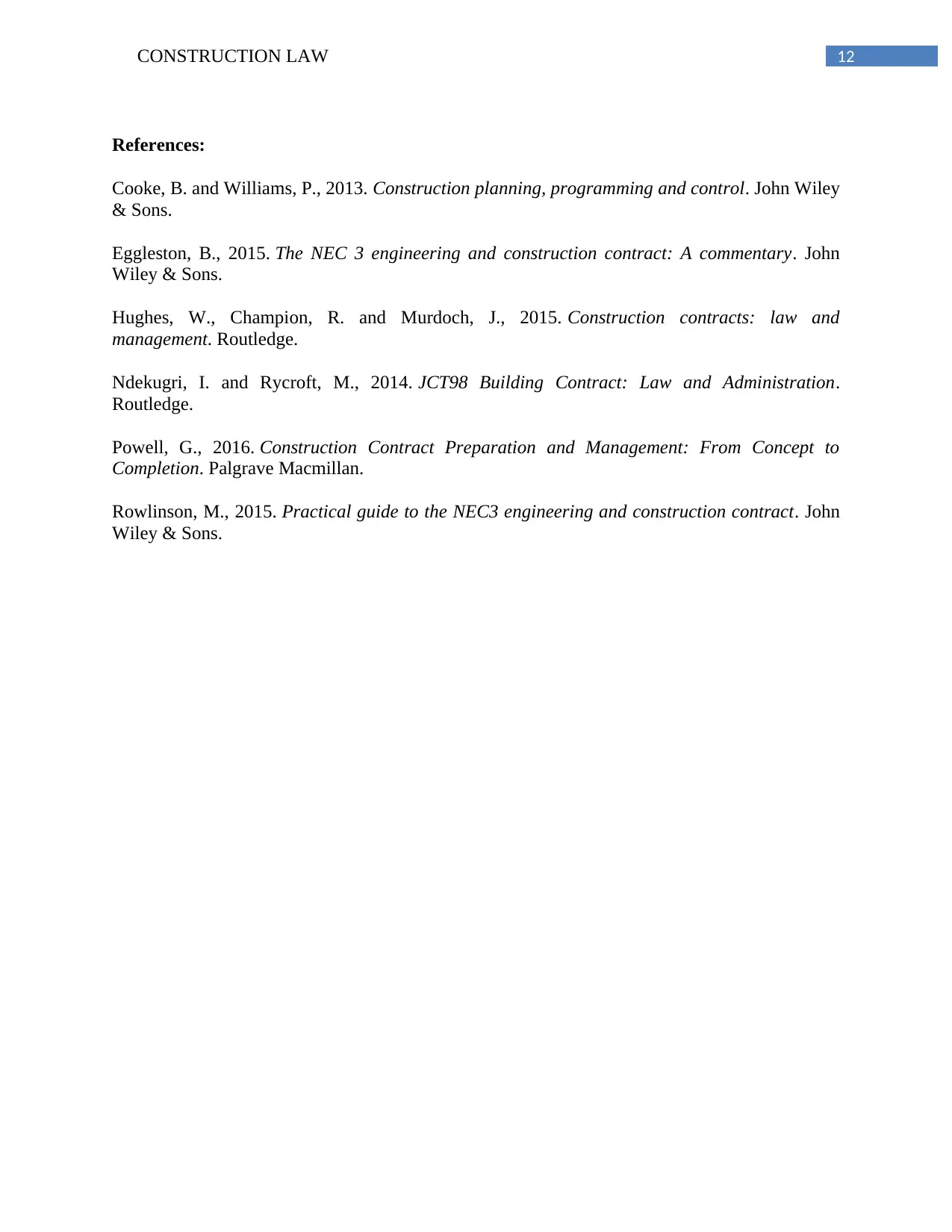
12CONSTRUCTION LAW
References:
Cooke, B. and Williams, P., 2013. Construction planning, programming and control. John Wiley
& Sons.
Eggleston, B., 2015. The NEC 3 engineering and construction contract: A commentary. John
Wiley & Sons.
Hughes, W., Champion, R. and Murdoch, J., 2015. Construction contracts: law and
management. Routledge.
Ndekugri, I. and Rycroft, M., 2014. JCT98 Building Contract: Law and Administration.
Routledge.
Powell, G., 2016. Construction Contract Preparation and Management: From Concept to
Completion. Palgrave Macmillan.
Rowlinson, M., 2015. Practical guide to the NEC3 engineering and construction contract. John
Wiley & Sons.
References:
Cooke, B. and Williams, P., 2013. Construction planning, programming and control. John Wiley
& Sons.
Eggleston, B., 2015. The NEC 3 engineering and construction contract: A commentary. John
Wiley & Sons.
Hughes, W., Champion, R. and Murdoch, J., 2015. Construction contracts: law and
management. Routledge.
Ndekugri, I. and Rycroft, M., 2014. JCT98 Building Contract: Law and Administration.
Routledge.
Powell, G., 2016. Construction Contract Preparation and Management: From Concept to
Completion. Palgrave Macmillan.
Rowlinson, M., 2015. Practical guide to the NEC3 engineering and construction contract. John
Wiley & Sons.
1 out of 13
![[object Object]](/_next/static/media/star-bottom.7253800d.svg)





